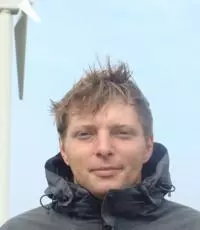Frédéric graduated with a PhD diploma in Fluid Mechanics from Ecole Centrale de Lyon in 2014. Since then, he works as a research engineer at IFPEN. Frédéric’s reasearch focuses on both the aerodynamics of wind turbine rotors and atmospheric flows within wind farms, including wake effects. He developed and implemented several models for the DeepLines WindTM aero-hydro-servo-elastic solver, including BEM, vortex methods, or Vertical Axis Wind Turbine dedicated models. Recently, Frédéric has been interested in wind farm flows, developing so-called “engineering” steady-state and dynamic analytical models but also working on high-fidelity Large-Eddy-Simulation and meteorological solvers, based on Navier-Stokes (SOWFA/OpenFOAM, Meso-NH) but also Lattice Boltzmann (waLBerla) frameworks in order to develop tools that can be used in real time. A particular focus is put on the interaction between wind turbine wakes and the Atmospheric Boundary Layer. Frédéric is involved in projects both at national (ANR) and international level (H2020). He supervises several PhD students and actively participates in IEA Wind tasks.
- Projet H2020 (2019-2022): EoCoE-II “Energy oriented Center of Excellence on HPC”. Partners: Cerfacs, Ciemat, CNR, CNRS, DDN, Enea, FAU, Fraunhofer, FZJ, IFPEN, Inria, MPG, PSNC, UBAH, ULB, UNITN
- Projet ANR (2020-2024): MOMENTA “farM rOtor ModEl accouNting aTmospheric wAke turbulence”. Partners: VALEMO, LA, IFPEN, LHEEA, PRISME, CREA
"LiDAR and SCADA data processing for interacting wind turbine wakes with comparison to analytical wake models", Renewable Energy, 2021. DOI: https://doi.org/10.1016/j.renene.2021.09.019.
“Multimodel validation of single wakes in neutral and stratified atmospheric conditions”, Wind Energy, 2020. DOI: https://doi.org/10.1002/we.2543.
“Comparing blade-element theory and vortex computations intended for modelling of yaw aerodynamics of a tethered rotorcraft”, TORQUE Conference 2020. DOI: http://dx.doi.org/10.1088/1742-6596/1618/3/032012.
“An alternative form of the super-Gaussian wind turbine wake model”, Wind Energy Science, 2020. DOI: http://dx.doi.org/10.5194/wes-5-1225-2020.
“An adaptation of the super-Gaussian wake model for yawed wind turbines”, TORQUE 2020. DOI: http://dx.doi.org/10.1088/1742-6596/1618/6/062031.
“Calibration of a super-Gaussian wake model with a focus on near-wake characteristics”, TORQUE 2020. DOI: http://dx.doi.org/10.1088/1742-6596/1618/6/062008.
“The Actuator Line Method in the Meteorological LES Model Meso-NH to Analyze the Horns Rev 1 Wind Farm Photo Case”, Frontiers in Earth Sciences, 2020. DOI: http://dx.doi.org/10.3389/feart.2019.00350.
“Coupling the actuator line method to the high order meteorological LES model Meso-NH to study wind farm wakes impacts on local meteorology”, WAKE 2019. DOI: http://dx.doi.org/10.1088/1742-6596/1256/1/012019.
“Comparison of Aero-Elastic Simulations and Measurements Performed on NENUPHAR’s 600kW Vertical Axis Wind Turbine: Impact of the Aerodynamic Modelling Methods”, TORQUE 2018. DOI: https://iopscience.iop.org/article/10.1088/1742-6596/1037/2/022010.
“Actuator-Line Model in a Lattice Boltzmann Framework for Wind Turbine Simulations”, TORQUE 2018. DOI: http://dx.doi.org/10.1088/1742-6596/1037/2/022023.
“Performance of two closely spaced turbines on a weathervaning floating platform, Wind Europe 2017. DOI: http://dx.doi.org/10.13140/RG.2.2.12174.66883.
“Improving a BEM Yaw Model Based on NewMexico Experimental Data and Vortex/CFD Simulations”, CFM 2017. https://hal.archives-ouvertes.fr/hal-01663643/
“Validation and comparison of aerodynamic modelling approaches for wind turbines”, TORQUE 2016. DOI: https://iopscience.iop.org/article/10.1088/1742-6596/753/2/022029.





